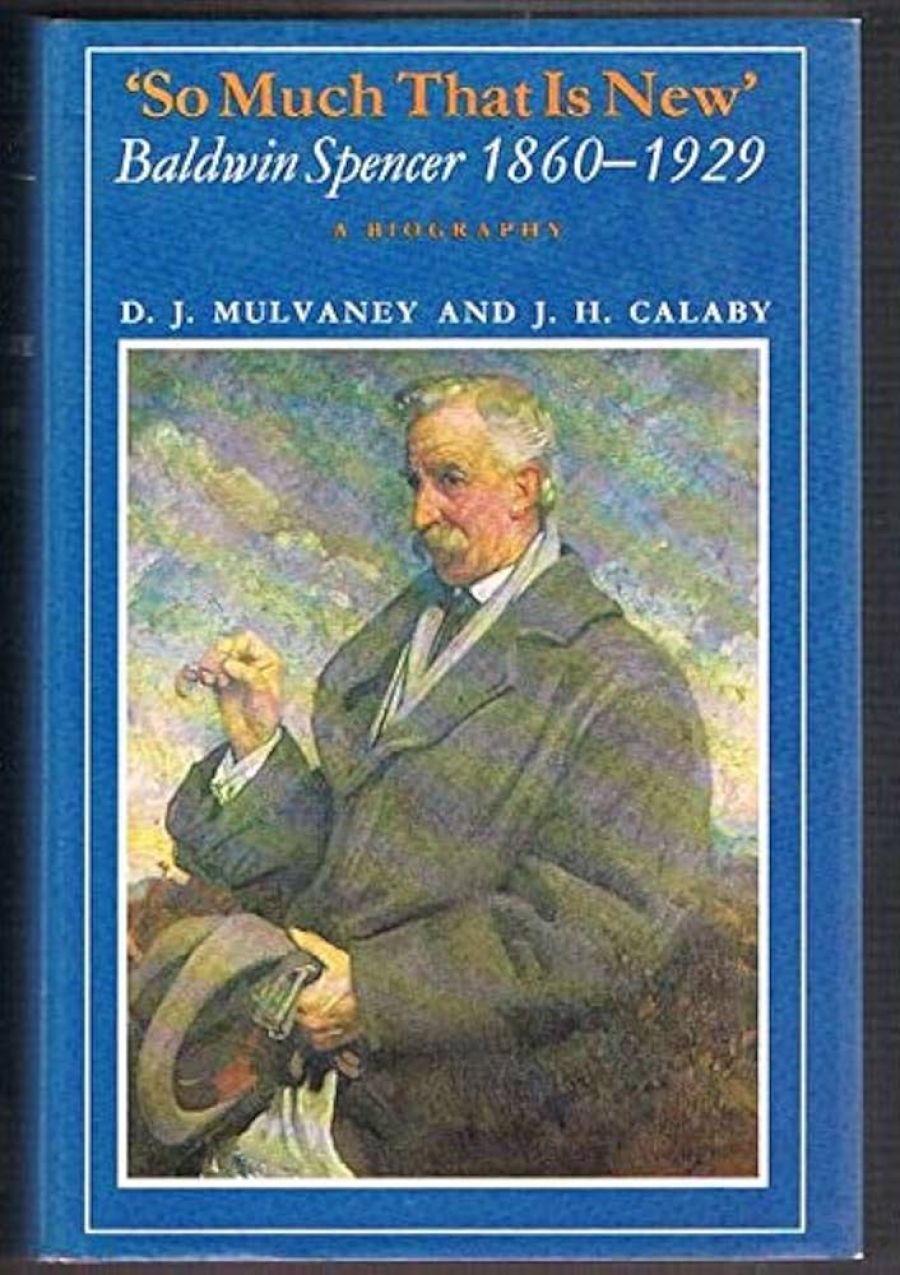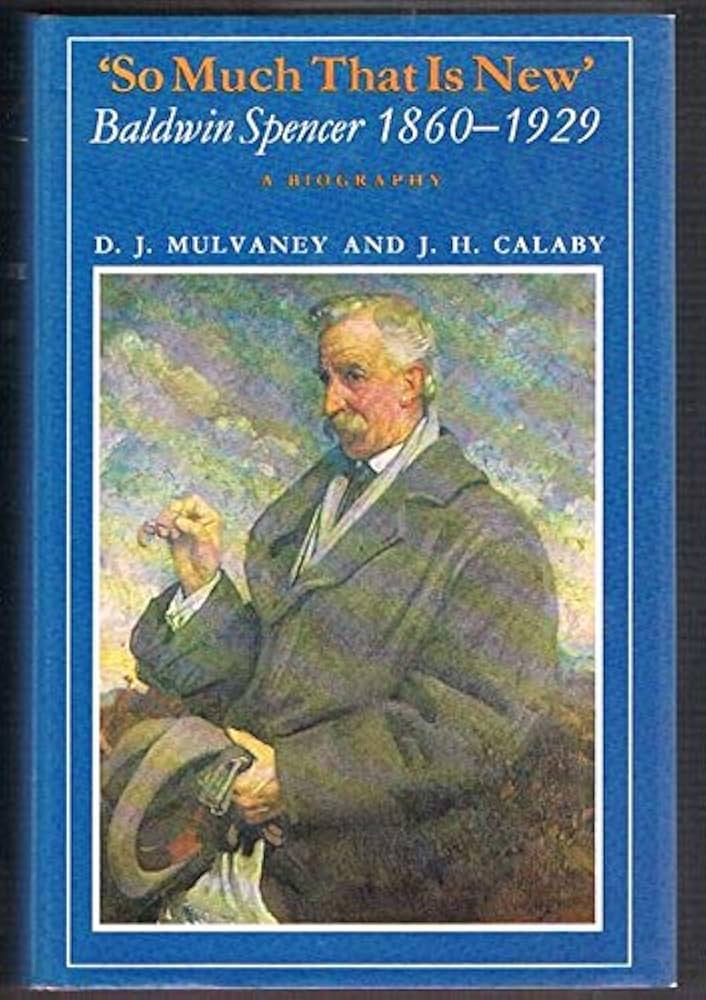
- Free Article: No
- Contents Category: Biography
- Review Article: Yes
- Article Title: Not Just a Biologist: Reviewing a grandfather’s life
- Online Only: No
- Custom Highlight Text:
Most biographies are about active people who do several things well but usually do them one at a time. As the publisher’s blurb says, Baldwin Spencer did many things and when Mulvaney came to describe his activities he found that the usual chronological approach used by most was not appropriate; four chapters of the book describe Spencer’s contribution from about 1895 to 1920 to biology, University administration, the Melbourne Museum and Australian art, and the reader must integrate these if he wishes to establish a chronology. Spencer’s anthropological work, including his stint as Special Commissioner for Aboriginals in Darwin in 1911, runs as a thread throughout the whole book. Biographers have to face up to controversies in the lives of their subjects and with Spencer these were the disintegration of his marriage, his lapse into alcoholism in the early twenties, and criticisms of his techniques as an anthropologist.
- Book 1 Title: So Much that is New: Baldwin Spencer 1860-1929
- Book 1 Biblio: Melbourne University Press, $33.50, 492pp
- Book 1 Cover Small (400 x 600):

- Book 1 Cover (800 x 1200):

I lived for about two years with my grandparents, moving with them from the house in Ferntree Gully to Toorak in 1923. My grandmother was by this time an unhappy woman; she had obviously not been able to cope or sympathise with Spencer’s energetic but self-centred pursuit of his many interests. Although she appreciated the trappings of success (she liked being called Lady Spencer) she did not appreciate the efforts required to gain them. Her returns to England, made every three years, and promised to her parents as a condition of parental approval of the marriage, must have been a strain; as Mulvaney points out, her absences in England did not always coincide with her husband’s field work and thus they were apart for much of the time. Apart from their children, they seemed to have few common interests; though she had originally liked sketching in watercolours, she obviously did not like his enthusiasm for Australian paintings (or Australian artists!) and he did not share her interests in music (she had sung with the Halle choir): though I remember him singing in an attractive light voice, he told Melba, when she offered him concert tickets, that he did not like caterwauling (though Hetherington has attributed this story to someone else). Apart from her dislike of his absence on field work, he funded much of this from his own income, a certain cause of matrimonial strife. Mulvaney has dealt skilfully with this aspect, leaving the reader to draw his own conclusions.
As we might expect, Mulvaney’s main contribution lies in a critical assessment of Spencer as anthropologist. His major contributions were the four books (three with Gillen): The Native Tribes of Central Australia (1899), The Northern Tribes of Central Australia (1904), The Native Tribes of the Northern Territory of Australia (1914) and The Arunta (1927). His interest in anthropology was stimulated when, accompanying the Horn expedition to central Australia as zoologist (and photographer), he met the Alice Springs postmaster, Frank Gillen, who was collecting information about the Aborigines of the area and contributed notes to the report on the expedition edited by Spencer. The two men kept in touch and, through Gillen‘s prompting, a number of clans gathered at Alice Springs to conduct ceremonies between September 1896 and January 1897. Observing these ceremonies and talking to the tribesmen provided much of the material for the first of the books and most of The Arunta.
The subsequent controversy between Spencer and the elder Strehlow of the Hermannsburg Mission over a belief in God by the Aborigines of the area depends heavily on the meaning of the Arunta word ‘altjira’. An earlier Hermannsburg missionary, H. Kempe, in a letter to Gillen in 1910 (I have the original pasted in one of the rare 1898 printings of the first book) states that this word did not denote a personal God, but something undefinable, old and mysterious; as Spencer and Gillen point out, the word was used in mission services in the native language as the nearest word in their vocabulary. In his last book, the popular Wanderings in Wild Australia, Spencer quotes English-speaking Aboriginals as describing the meaning as ‘The Dreaming’. This aspect of the difference of opinion between the elder Strehlow and Spencer seems to me to have overshadowed the important criticisms made by the younger Strehlow, a full-time anthropologist fluent in the Arunta (Aranda) language, that Gillen’s knowledge of it was rudimentary and that some of Spencer’s informants on the 1926 expedition were too young to have been fully initiated into tribal secrets early in the century. He admits that his father was not allowed to see tribal ceremonies, but says that criticism that he got his information from mission natives was not entirely correct, as much of it came from a tribal native he nursed back to health after being wounded by police while cattle stealing. As Mulvaney says, if Spencer and the elder Strehlow had met to discuss their differences much of the resultant confusion might have been avoided, as Spencer seems to have been able to get on well with all sorts of people. For instance, Professor Semon from Jena has told of his initial misgivings when he heard that another scientist was camped near the Burnett River also looking for lungfish, but when Spencer walked to his tent to meet him, they quickly became friends. No doubt the gap was greater with Strehlow, though mutual interests in Aboriginal culture might have closed it. But however many errors Spencer and Gillen may have made in interpreting the ceremonies they saw, their record of them (written, photographic and recorded) is unique, as the younger Strehlow agreed.
With the collections made by Spencer and his protege, Donald Thompson, and others, the Victorian Museum houses one of the great ethnological collections in the world, but, at present, after Spencer Hall was dismantled pending rearrangement of the museum and replaced by a stuffed horse, only one bark canoe from his collection is on display. However, I gather that the display of the collection should be improved soon when money becomes available. Fortunately, some of the priceless cinematographic films and gramophone recordings he made have been transferred to safety film and modern records.
Spencer’s anthropological work has overshadowed his zoology, yet it is for this that he got his FRS. Apart from his work on the pineal eye in reptiles and the anatomy of earthworms, Calaby considers that his major contribution lies in the report of the Expedition to which he contributed much of the zoology and edited the series of four books. However, as Calaby says, his publications in zoology tailed off as his anthropology took over, though about fifteen papers published by his students and associates after 1900 might well have had his name on them as co-author. In the Proceedings of the Royal Society of Victoria, Ewart and his botanists gradually replace the zoologists up till Spencer’s retirement in 1919.
Although Spencer’s contributions to assisting Australian artists is probably not well known now by any but specialists, he played an important part in encouraging the group now known as the Heidelberg school and others such as the Lindsay brothers (especially Norman) and George Lambert, whose fine portrait of Spencer, painted in London in 1917, makes a striking dust-cover to the book. As a Trustee and Assistant Director of the Melbourne National Gallery he seems to have been in a minority and had to see his fellow Trustees encouraging the buying of much that he disapproved.
The period of his retirement after 1919 must have been the low ebb in his life; his wife was away again in England and the University had neglected his offer to act as honorary Reader in Anthropology. These factors must have contributed to his lapse into alcoholism in the early twenties and it was not till his friendship with Jean Hamilton developed that he overcame it, permitting the final burst of energy that resulted in the publication of The Arunta and Wanderings in Wild Australia, and his final ‘last journey’ to Tierra del Fuego where he died in 1929.
The book is generously illustrated, with coloured plates of his four portraits painted by Australians, though it does not include any of Spencer’s numerous photographs from his books showing Aboriginal customs and ceremonies; for these the excellent production by Mulvaney, The Aboriginal Photographs of Baldwin Spencer, should be consulted. Geoffrey Blainey’s Centenary History of the University of Melbourne and Spencer’s Last Journey by Mareet and Penniman also provide interesting collateral reading. Although at first sight it is heavy on detail and light on anecdote, to anyone interested in Aborigines, zoology of the local fauna, Melbourne University, art in Australia or just Melbourne itself, this book has much to offer.


Comments powered by CComment